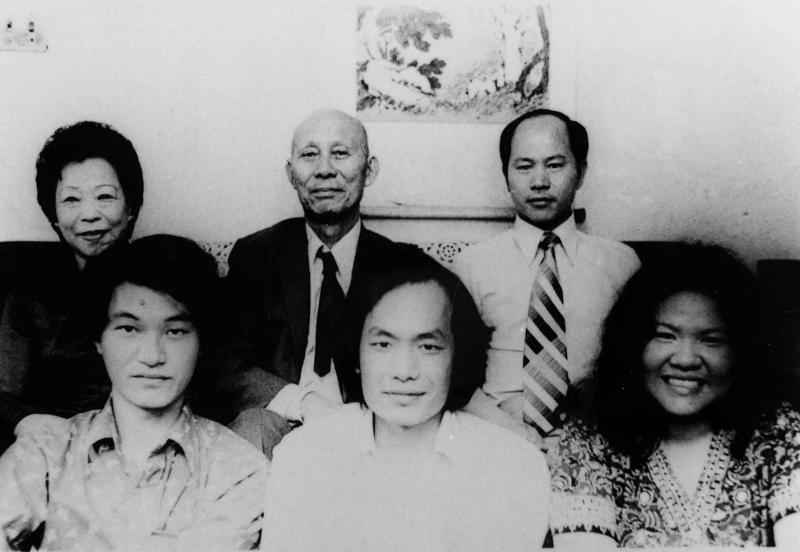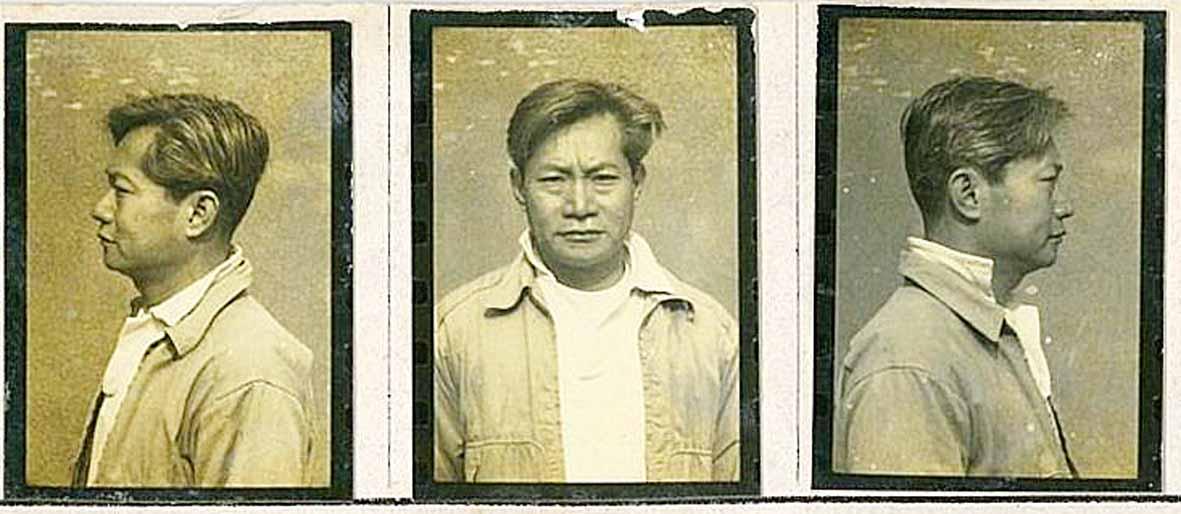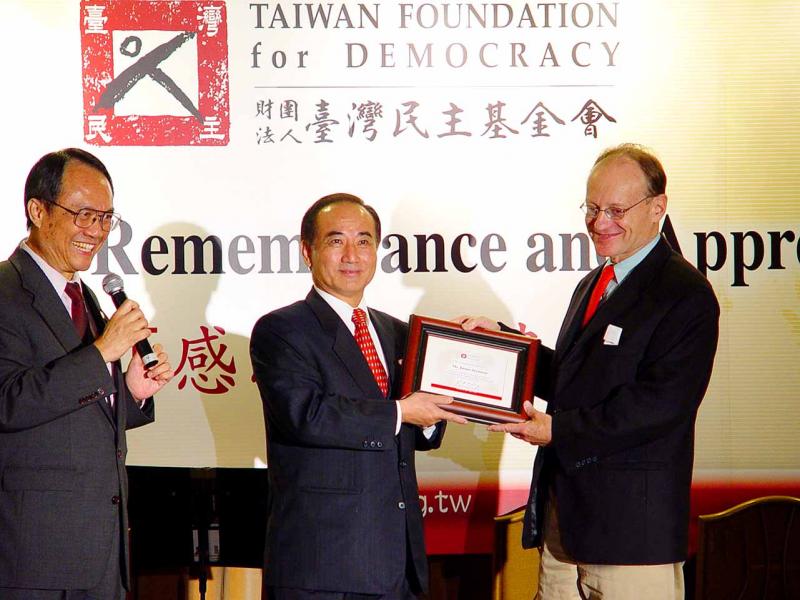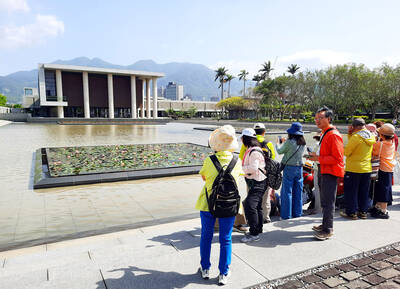As we have come out of an era of silenced voices and confiscated photographs, we know the preciousness of those slivered shards of memory: the pieces of writing that were half-veiled critiques of the Chinese Nationalist Party (KMT) authoritarian regime, trying to hide behind stock phrases that could not be construed as sedition, and yet bite; the faded and poorly-focused photographs were usually taken by amateurs, who yet were driven to capture the fleeting moment when a few foolhardy souls ventured to gather and join in protest.
The negatives and pictures, fading and molding in Taiwan’s humid climate as they lay for years in hidden and forgotten places, fared worse than the written record. For example, Chen Po-wen (陳博文), the main photographer during the 1979 Kaohsiung Incident (美麗島事件), ran an X-ray processing shop in Taichung where he could process his own photographs; as police moved in to arrest him early in the morning in December 1979, Chen hid photo negatives between stacks of large X-rays, not re-discovered until the late 1990’s.
These photographs have since been the basis for several exhibitions. Other photos have been released by the National Archives Administration to relatives of political prisoners, but are not generally available. These early photos are even more precious because of their scarcity, and they tell us more about human nature than words, as we witness, for example, the faint look of bravado on the face of a person facing the firing squad.

Photo courtesy of Taiwan Foundation for Democracy
COPYRIGHT RESTRICTIONS
And now as we try to recover and transmit history, we face a new hurdle: copyright restrictions. Aside from the restrictions that claim to protect ownership for private parties, we face exaggerated privacy claims, such that names on documents from the national archives are often blacked out. So those who are motivated to research and write history face an obstacle course of legal, financial and administrative hurdles.
Now let me get specific. The Taiwan Foundation for Democracy (TFD) was founded in 2003 at the request of then-president Chen Shui-bian (陳水扁); funding came from the Ministry of Foreign Affairs. The titular head was the KMT’s Wang Jin-pyng (王金平), the then-speaker of the Legislative Yuan. Kao Ying-mao (高英茂), a professor of political science, was named the director. TFD has been able to promote international recognition for Taiwan’s advance towards democracy, a considerable part of its new legitimation in international society.

Photo courtesy of Vinay Chen
The first activity of the TFD — “The Struggle for Democracy and Human Rights: A Journey of Remembrance and Appreciation”(感恩與巡禮: 國際友人對台灣民主與人權奮鬥的回顧) — was to invite back to Taiwan on Dec. 8 and Dec. 9, 2003, 30 foreign nationals who had been expelled in the period of martial law. The list of invitees was drawn up by Lynn Miles, who knew most of them from his years running an underground human rights network based in Osaka.
This program included some KMT-affiliated figures who were willing to come, such as KMT legislator John Chiang (蔣孝嚴), a son of former president Chiang Ching-kuo (蔣經國). It was an emotional moment when the elder sister of Chen Wen-cheng (陳文成), a mathematics professor from Pittsburgh found dead on July 3, 1981, the day after being taken in for questioning by the security agencies, addressed Chiang as a fellow family member of White Terror victims.
A further highlight was that US missionary Milo Thornberry and his wife Judith Thomas revealed that they had carried out the January 1970 escape of democracy pioneer Peng Ming-min (彭明敏) from house arrest in Taiwan — not the US Central Intelligence Agency, as many had assumed. My significant part was to insist that we make an enduring record of each person’s experience, on videotape.

Photo courtesy of Taiwan Foundation for Democracy
Subsequently Lynn Miles and I used these for our 500-page, 2008 book, A Borrowed Voice: Taiwan Human Rights through International Networks, 1960-1980 (我的聲音借你: 台灣人權訴求與國際聯絡網). This book remains the main record of this history, and will be available for free download in English and Chinese next month through the Jing-Mei White Terror Memorial Park (白色恐怖景美紀念園區), under the title International Contributors to Taiwan Human Rights: vr360.nhrm.gov.tw/ftpp/.
HUMAN RIGHTS EXHIBITION
The Jing-mei White Terror Memorial Park last year began to plan an exhibition for December on the overseas contributors to Taiwan human rights, and asked me to be a consultant. Soon, however, the expanding pandemic nixed our plans for inviting the few surviving foreign participants. So I planned a colorful book to accompany the exhibit, and researched their later lives for an updated account. Then the contractor for the exhibit contacted the TFD, and was told none of the 2003 materials could be found; perhaps they were dumped during the Ma Ying-jeou (馬英九) presidency (2008-2016), when it was rumored that TFD itself barely survived.
The pictures were all on my computer, but it took considerable searching before I found the 2003 video interviews on CD’s stacked inside plastic crates on my porch — many soaked in a recent typhoon, but fortunately spared. The contractor made copies and gave them to TFD, and requested formal permission to use them.
And then I waited. That was over six months ago. After many internal pass-the-bucks the contractor was told that TFD legal consultants said that it could not provide permission because they do not hold permissions from those in the 2003 activity. But giving this specious excuse, thinking narrowly in terms of commercial copyright, TFD seems, more importantly, to be violating its mission to promote Taiwan’s image of liberty and democracy.
I just heard about this problem with TFD two weeks ago as I am almost finished, after about eight months’ work, putting together a 300-page book with biographies of nearly 90 participants, with most photos taken at the 2003 conference, then still relatively young and active. After consulting with several authors and reporters, I understand that use of pictures taken in public spaces do not require the permission of the persons whose picture is taken. Commercially, they belong to the photographer who has taken the picture, or to the institution that arranged for it.
However, I have learned from another historian that it is indeed very difficult to get any organization to sign off on permission to use photographs, if just perhaps because of bureaucratic inertia. Where the pictures can be paid for commercially, the process still takes considerable administrative time and effort. But government organizations in particular want to cover themselves from any potential indemnity and thus take a narrow interpretation for how written permissions should be provided for their publications with pictures.
Now I want to ask: who has the right to write history? And who is willing to spend the effort and is able to write history, if the doors to sources are closed?
I contend that we cannot treat historical materials like commercial property, in particular those dating from or dealing with Taiwan’s Martial Law era. It is not justified to say that these materials belong even to the leaders of the political movements of that time. Instead, they represent the mass phenomena of mobilization of thousands of people. And they are only meaningful if they are a legacy to the next generation. All institutions and holders should make these photographs open to public use. I intend to put all the photographs I hold onto a Web site with a statement that they can be used as public domain. We must create a rich historical record for future generations to freely read and see, if only they are willing.

When the South Vietnamese capital of Saigon fell to the North Vietnamese forces 50 years ago this week, it prompted a mass exodus of some 2 million people — hundreds of thousands fleeing perilously on small boats across open water to escape the communist regime. Many ultimately settled in Southern California’s Orange County in an area now known as “Little Saigon,” not far from Marine Corps Base Camp Pendleton, where the first refugees were airlifted upon reaching the US. The diaspora now also has significant populations in Virginia, Texas and Washington state, as well as in countries including France and Australia.

On April 17, Chinese Nationalist Party (KMT) Chairman Eric Chu (朱立倫) launched a bold campaign to revive and revitalize the KMT base by calling for an impromptu rally at the Taipei prosecutor’s offices to protest recent arrests of KMT recall campaigners over allegations of forgery and fraud involving signatures of dead voters. The protest had no time to apply for permits and was illegal, but that played into the sense of opposition grievance at alleged weaponization of the judiciary by the Democratic Progressive Party (DPP) to “annihilate” the opposition parties. Blamed for faltering recall campaigns and faced with a KMT chair

Article 2 of the Additional Articles of the Constitution of the Republic of China (中華民國憲法增修條文) stipulates that upon a vote of no confidence in the premier, the president can dissolve the legislature within 10 days. If the legislature is dissolved, a new legislative election must be held within 60 days, and the legislators’ terms will then be reckoned from that election. Two weeks ago Taipei Mayor Chiang Wan-an (蔣萬安) of the Chinese Nationalist Party (KMT) proposed that the legislature hold a vote of no confidence in the premier and dare the president to dissolve the legislature. The legislature is currently controlled

Dull functional structures dominate Taiwan’s cityscapes. But that’s slowly changing, thanks to talented architects and patrons with deep pockets. Since the start of the 21st century, the country has gained several alluring landmark buildings, including the two described below. NUNG CHAN MONASTERY Dharma Drum Mountain (法鼓山, DDM) is one of Taiwan’s most prominent religious organizations. Under the leadership of Buddhist Master Sheng Yen (聖嚴), who died in 2009, it developed into an international Buddhist foundation active in the spiritual, cultural and educational spheres. Since 2005, DDM’s principal base has been its sprawling hillside complex in New Taipei City’s Jinshan District (金山). But